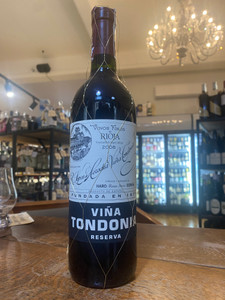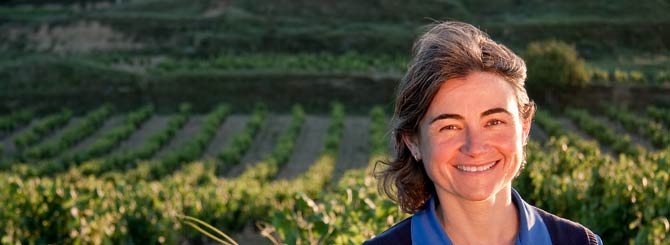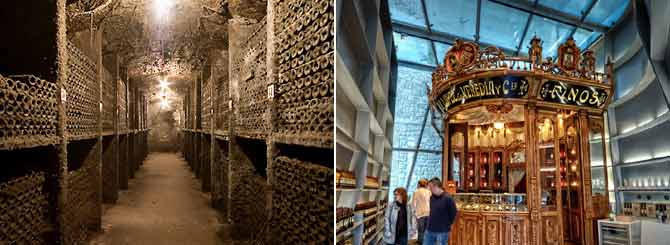
"The colour is a vibrant red leading slightly towards amber. The nose on the 2007 is light with both fresh and dried berry aromas alongside boysenberry and vanilla. On the palate it is rich in texture, very dry, smooth, developed. Firm tannins and good balance."
R. Lopez Heredia Vina Tondonia
1. A plague on both your houses
A great bastion of tradition, this "old-fashioned and proud of it" bodega was founded in 1877 at the height of the phylloxera epidemic that devastated vineyards across France in the 19th Century. As a result, French negociants from Bordeaux were forced to seek new land to cultivate and soon arrived in Rioja's regional capital, Haro, looking to recover their losses. They quickly realized that although conditions were different from those they knew in Bordeaux, it would still be possible to produce good wines – as was subsequently demonstrated when they dramatically improved wine production in Rioja.
2. A legend is born
It was this newfound interest in a formerly unremarkable corner of Spain that first attracted a Chilean student of wine, Don Rafael López de Heredia, to the small village of Haro. Quickly sensing the exceptional potential of Rioja Alta, he founded Haro's first major winery – López de Heredia.
Don Rafael wasted no time in drawing up plans for his pet project, which would include an imposing winery designed to emulate the great châteaux of Bordeaux. The bodega's distinctive tower, christened "Txori Toki" (birdhouse in Basque) dates back from 1892, when Don Rafael decided the bodega needed an observation post from which to study his vineyards and the incoming weather (not to mention the marketing clout of having one's name displayed several hundred feet above the ground). Construction of the cellars, offices and family residence took place over a period of several decades into the early 20th Century, using quarried stone.
3.Viña Tondonia
After establishing a base of operations in Haro, Don Rafael quickly realized that he couldn't make superlative wine without the corresponding raw materials. Therefore, he founded what is arguably Rioja's most famous vineyard, Viña Tondonia, on alluvial and limestone soils between 1913-14. He subsequently planted three additional vineyards in the Rioja Alta sub-zone: Viña Cubillo, Viña Bosconia and Viña Zaconia.
However, it is Tondonia that really excites López de Heredia aficionados; a beautiful shell-like expanse of vines, which flanks the River Ebro and serves as a border to the Rioja Alavesa sub-region further north. It continues to provide the fruit for the winery's top Reserva and Gran Reserva wines. Today, the bodega owns 180 hectares (445 acres) of land in total, with 110 ha currently in production. The remaining land is allowed to "recover" for a period of up to 14 years and is used to grow cereals.

© Lopez de Heredia | Maria Jose Lopez de Heredia is the latest generation to work the land, along with sister Mercedes.
4. If it ain't broke, don't fix it
Under the direction of Don Rafael's descendants, López de Heredia has stayed remarkably true to its roots. In fact, current sister duo Maria José and Mercedes Lopez de Heredia claim that nothing has essentially changed in the winemaking since the 19th Century. "We continue to cultivate the vineyards and indeed make our wines following the techniques and philosophies laid down over 140 years ago," says Maria José Lopez de Heredia. "This has been no accident – we have taken the conscious and voluntary decision not to use modern technology in our winemaking."
5. Watch your step
Entering this iconic bodega's cellar is a journey back through time and is an essential stop on any visiting enophile's itinerary. Their cellars are 15 meters below ground, which, according to Maria José, helps to maintain an even temperature of 12C. Over 3000 square meters of cellar space has been expanded and improved upon over a 100-year period. Inside, you'll find 12,900 American oak barrels, 72 ancient wooden fermentation vats still in use, wine transference by hand in cellars black with mould and giant cobwebs designed to terrify the arachnophobics among us. Oh, and they have their own cooperage.
6. Flipping the bird to modernity
The winemaking at López de Heredia stands in marked contrast to the approach adopted by Spain's growing firmament of new-wave producers, eschewing both modern technology and the powerful kiss of new French oak. Instead, Maria José favours long ageing regimes and unfiltered wines that are the anthesis of concentrated, fruit-driven Rioja. All the wines start their life in old oak vats, sourced from Spain, the US, France and the former Yugoslavia. Most are then subject to a prolonged ageing regime in used barrels, with the bodega's small assortment of new barrels reserved for very young wines. The silky smooth Tondonia Reserva for example, spends six years in wood while the Gran Reserva is aged for 10 years. Moreover, the wines are subject to frequent racking, egg-white fining, and are bottled without filtration.
But are they a ridiculous anachronism in a region increasingly committed to modernization?
7. The rebuttal
"López de Heredia will never changes its approach, for two reasons," answers Maria José. "Firstly, our customers constantly tell us that they like our historical approach to Rioja production and the resulting wine style it gives. Secondly, we don't desire change; we like the results of what we do."
Maria José has also been a staunch critic of the Spanish paradigm that a dollop of new oak heals all winemaking deficiencies. "New oak has become too prominent a force in Spanish winemaking," she argues. "The cask historically was simply used to transport wine – it was never intended as an enological tool. Oak should remain a secondary feature of wine production, used to stabilize wine, rather than used to impart aromas or flavours that trample over the fruit and terroir character."

© Lopez de Heredia | The winery at Haro is a blend of modern and traditional.
8. NV Rioja
López de Heredia produces a wide range of red wines at different price-points, although the house style of oaked refinement and a lightness of structure comes shining through in the entire portfolio. Viña Cubillo is the younger range, with a large dollop of Garnacho added, while the Bosconia Reserva and Gran Reservas are richer, more complex wines.
Of course it's the Tondonia Reserva and Gran Reservas that frequently attract the most acclaim. The 2003 Tondonia Reserva is typical of the standard Tondonia blend, comprising 70 percent Tempranillo, 20 percent Garnacho, 5 percent Graciano and 5 percent Mazuelo, fermented with natural yeasts. Nothing unusual there; however, in another breakaway move, López de Heredia permits reserve wines (up to 15 percent) in their cuvées, as Maria José argues it maintains consistency throughout the vintages. In total, between 300,000 to 400,000 bottles are produced per annum, depending on the vintage.
9. Tondonia Blanco
In a region that has (until relatively recently) largely marginalized white Rioja styles, López de Heredia once again stands out due to a considerable output of aged, complex white wines. Indeed, about a quarter of the wines made at this venerable bodega are whites, including the smooth, elegant and utterly delicious Gravonia. The 2000 is a classic case in point: based on 100 percent Viura, the wine is aged in oak for four years and is a classy, well-balanced wine of considerable proportions.
Yet the Tondonia Reserva and Gran Reserva whites are in a completely different league altogether. Indeed, these remarkable wines are aged in barrel for longer than any other white wine in the world, imbuing them with a legendary aromatic complexity and depth of flavour, underpinned by a silky sweetness. For, unlike modern-style whites, López de Heredia consciously rejects primary fruit flavours in favour of secondary and tertiary aromas – these are wines perhaps best avoided by those searching for clean, uncomplicated winemaking.
But for the rest of us, they represent the pinnacle of classical white Rioja. The 2000 Tondonia Reserva, composed of 90 percent Viura and 10 percent Malvasia, is a firm favourite with the Wine Advocate, who noted that: "There are plenty of balsamic aromas plus notes of old furniture, waxed noble woods, pollen and honey that show slightly more evolved than the 2001. The wine fills your palate, has great intensity, focused flavours, very good acidity and persistence."
Rioja Red Blend
The red wines of Rioja are some of the most well known and widely drunk wines across the globe. Tempranillo is the king grape of the Rioja region and where it really excels however the best blends feature its good friend Garnacha. Together they produce fruity, spicy, savoury and lip-licking reds. The more traditional Rioja reds will have more oak, the newer will have less so.








